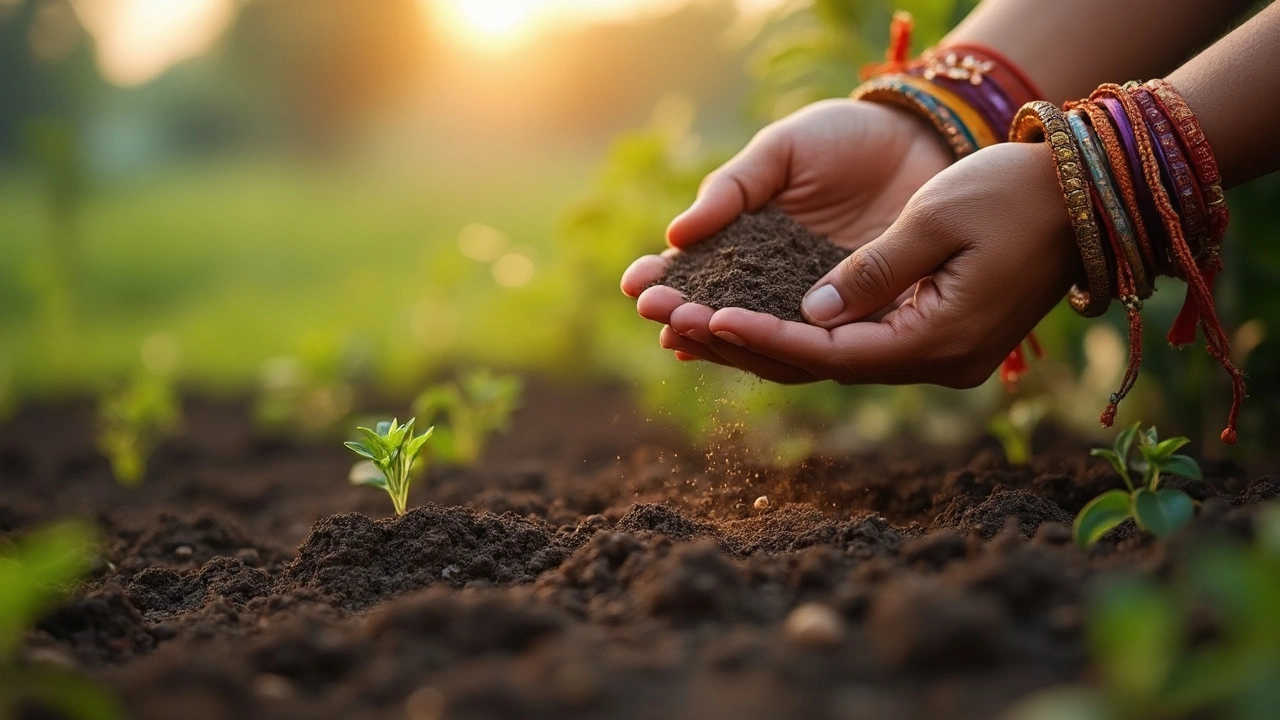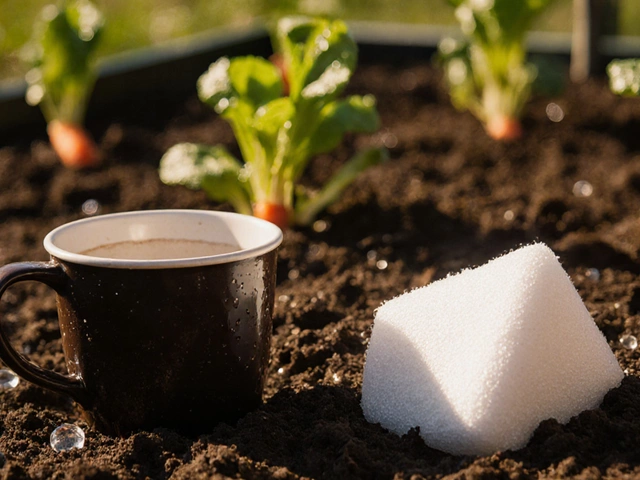Ever wondered why some gardens look like they've been blessed by the vegetable gods while others barely manage a tomato or two? The secret often lies beneath the surface—in the soil itself. For anyone looking to grow a lush vegetable garden, having the right soil is like having a superpower.
First things first, you've got to understand what your soil is working with. Is it sandy, clay-like, or just right? Sandy soil drains too fast, while clay holds onto water for dear life. You need that Goldilocks zone—a loamy mix that's got enough of both.
Now, let's talk about organic matter, the not-so-secret sauce of gardening. Compost, aged manure, and even coffee grounds can turn sad earth into a thriving ecosystem for your veggies. This stuff improves drainage, holds moisture better, and invites all the right kinds of microbes to the party.
- Understanding Your Soil's Needs
- The Magic of Organic Matter
- Adjusting Soil pH for Veggie Success
- Nutrients: The Building Blocks
- Best Practices for Soil Amendment
Understanding Your Soil's Needs
Diving into soil science might not be your idea of fun, but a little knowledge here can go a long way. Let's start by figuring out what kind of soil you've got in your garden. It's like a soil personality test!
Identify Your Soil Type
Grab a handful of soil, squeeze it, and see what happens. If it forms a tight ball, it's probably clay. If it's more like dust slipping through your fingers, that's sandy soil. Ideal soil, also known as loam, will mold into a roll without falling apart.
Testing for Soil Drainage
Drainage matters more than you think. A simple way to check is by digging a hole about 12 inches deep and filling it with water. Let it drain, then fill it again. If the water takes hours to disappear the second time, you've got a drainage problem.
How to Check Soil Nutrient Levels
You might be able to DIY it, but a soil test kit from a garden center makes it easy-peasy. Knowing nutrient levels helps in picking the right amendments later on to boost that vegetable garden soil. Look specifically for nitrogen, potassium, and phosphorus levels.
To make things more fun, here's an average pH level table based on soil type:
| Soil Type | Average pH Level |
|---|---|
| Sandy | 5.5-7.0 |
| Clay | 6.0-7.5 |
| Loam | 6.0-7.0 |
The pH level affects nutrient availability, so getting this right is crucial.
The Magic of Organic Matter
Let's dish the dirt on why organic matter is a big deal for your vegetable garden soil. Think of it as giving your garden a vitamin boost. Organic matter isn't just garden waste; it's a nutrient-rich treasure trove that transforms plain soil into fertile ground.
When you mix organic matter into your soil, you're doing a few things. First, it lightens heavy clay and boosts the water-holding skills of sandy soils, getting you closer to that ideal loamy texture. It's all about striking the right balance so your plants aren't drowning or drying out.
Compost: The Ultimate Soil Conditioner
Compost is like the Swiss Army knife of soil enhancers. It adds nutrients, improves drainage, and even fights off nasty plant diseases. Start by piling up kitchen scraps, leaves, and grass clippings. Give it a mix every so often, and boom—you've got black gold.
Aged Manure: Not Just for Farmers
Upon hearing "manure," folks usually think of smell, but aged manure is an excellent soil amendment and hardly stinks at all. It's full of nitrogen, which is crucial for leafy greens. But just a heads-up, fresh manure can be too strong, so always go for the aged stuff.
Worm Castings: An Underrated Powerhouse
Worm castings might sound icky, but they're pure magic for your garden soil tips. They're rich in beneficial bacteria, enzymes, and nutrients. Plus, they can boost your soil's ability to retain water and aerate itself.
Adding these materials into your soil isn't about following a strict recipe. It's more of an art form, adapting to what your garden needs. Test different combinations and see what makes your veggies happiest. Remember, the more you invest in your soil, the more your garden rewards you.
If you want a quick look at what organic matter can do, here you go:
| Organic Matter | Main Benefit |
|---|---|
| Compost | Increases nutrients and improves soil structure |
| Aged Manure | Boosts nitrogen levels |
| Worm Castings | Enhances water retention |

Adjusting Soil pH for Veggie Success
Alright, let's dive into something a bit science-y but totally essential: soil pH. Think of pH as a mood ring for your soil. Most veggies have a sweet spot, usually between 6.0 and 7.5 pH, where they grow their best. If the soil's too acidic or too alkaline, it’s kind of like sending them to a party where they know none of the guests.
First things first: get a soil pH test kit. It's like a magic wand that tells you how your soil is vibing. These kits are pretty straightforward, and you can find them at most garden centers or online. Once you know the pH, you can start tweaking.
Making the Adjustments
If your soil's pH turns out too low (acidic), you’ll want to sweeten things up with some lime. There are different types—pelletized, ground, or hydrated—so follow the package directions for the right amount.
On the other hand, if you’ve got alkaline soil (too high a pH), sulfur or aluminum sulfate can help bring it down. Again, read up on the application rates since more isn't always merrier.
Why it Matters
The right pH means your plants can actually absorb the nutrients you’re working so hard to provide with your awesome soil amendments. It's like adjusting the volume so your plants hear everything they need to grow big and strong.
Now, this part isn’t super common knowledge, but according to a survey from the National Gardening Association, only about 30% of backyard gardeners test their soil pH regularly. Don't let your garden be part of the clueless majority. Be a soil hero!
- Test your soil pH to know where you stand.
- Use lime to raise pH and sulfur to lower it.
- Keep the veggie sweet spot in mind: 6.0 to 7.5 pH.
Nail this down, and you're one step closer to a stellar veggie patch. Happy gardening!
Nutrients: The Building Blocks
If your vegetable garden is in need of some serious TLC, then it's time to talk nutrients. Think of them as the essential vitamins and minerals your plants need to grow healthy and strong. Just like us, veggies need a well-rounded diet to thrive.
There are three major nutrients—often called macronutrients—you need to keep track of: nitrogen (N), phosphorus (P), and potassium (K). If you've ever seen a bag of fertilizer, you've probably noticed the N-P-K numbers. These are like a nutrition label for your soil!
Why Nitrogen?
Nitrogen is what helps your plants grow tall and green. It's crucial for leaf development, especially in greenery like lettuce and spinach. If you notice yellowing leaves, your soil might be lacking nitrogen.
The Role of Phosphorus
Phosphorus helps with root growth and flower production. It's key for vegetables that produce fruit, like tomatoes. Plants with purple-tinged leaves often signal a phosphorus deficiency.
Power of Potassium
Potassium is all about overall health. It heightens your plant's resistance to diseases and aids in water absorption. Curling leaves could mean your plants are calling out for more potassium.
To know exactly how much of these nutrients your soil has or lacks, consider getting a soil test. You can buy kits online or send a sample to a local extension service. Once you understand your soil's condition, you can choose the right fertilizer or organic material to boost those nutrient levels. Here's the basic idea:
- Add compost or well-rotted manure to boost nitrogen.
- Use bone meal to increase phosphorus levels.
- Try wood ash or kelp meal for potassium.
| Nutrient | Role | Deficiency Signs |
|---|---|---|
| Nitrogen (N) | Leaf growth | Yellowing leaves |
| Phosphorus (P) | Root & flower production | Purple-tinged leaves |
| Potassium (K) | Overall health | Curling leaves |
With the right combination of these super nutrients, your vegetable garden soil will be primed to support a thriving, productive garden year-round.

Best Practices for Soil Amendment
Getting your vegetable garden soil just right takes a bit of know-how. Think of it like setting the perfect base for a pizza—without that, your toppings (aka plants) won't do so great. Let's break down some best practices to ensure your veggies thrive.
Test Before You Tweak
Before you dive in, it's crucial to test your soil. Knowing its pH and nutrient levels can guide your amendment strategy. Home test kits are available, or you can send a sample to a local extension service for precise details.
Organic Matter is Your Best Friend
One of the easiest ways to boost your garden is by adding organic matter. Compost, aged manure, and even things like mulched leaves are gold for soil health. Spread a generous layer—about one to two inches—over your garden bed, and then mix it into the top six inches of soil.
Balance the Soil Structure
If your soil's making your gardening life hard by being too sandy or too heavy with clay, add the opposite type to balance it out and follow up with organic matter. This mix helps create that ideal loamy texture, improving both drainage and moisture retention.
Feed the Soil, Not Just the Plants
Fertilizers are good, but they mostly feed the plants directly. Garden soil benefits more from a slow and steady approach. Think bone meal for phosphorus or rock dust for trace minerals—these amendments nurture the soil food web, which in turn supports plant growth.
Don’t Forget Cover Crops
- Cover crops like clover or rye are great off-season plants. They add organic material and crucial nutrients, prevent erosion,
- fix nitrogen, and help with weed control.
So, remember, the key to a bountiful veggie garden often lies in well-amended soil. With a little preparation, your plants will reward you with a delicious and healthy bounty.




